-
Publish Your Research/Review Articles in our High Quality Journal for just USD $99*+Taxes( *T&C Apply)
Offer Ends On
Nazarbayev Khursand, Gulnoza Toshpulatova*, Asliddin Nuriddinov, Gulzira Narkizilova, Sayfulla Boboyev, Mirvakhob Mirakhmedov, Abdukayum Bekmukhamedov and Ulug‘bek Abdukarimov Shakhzoda Mukhamadiyeva
Corresponding Author: Gulnoza Toshpulatova, Department of Biology, National University of Uzbekistan, Almazar district, University St. Tashkent City, Uzbekistan.
Received: January 24, 2025 ; Revised: February 06, 2025 ; Accepted: February 09, 2025 ; Available Online: February 13, 2025
Citation: Khursand N, Toshpulatova G, Nuriddinov A, Narkizilova G, Boboyev S, et al. (2025) Inheritance and Variability of Fiber Yield, Length, as well as Some Fiber Quality Indicators in Various Cotton Hybrids. J Agric For Meterol Stud, 4(1): 1-8.
Copyrights: ©2025 Khursand N, Toshpulatova G, Nuriddinov A, Narkizilova G, Boboyev S, et al. This is an open-access article distributed under the terms of the Creative Commons Attribution License, which permits unrestricted use, distribution, and reproduction in any medium, provided the original author and source are credited.
Views & Citations
Likes & Shares
The article analyzes data on the study of patterns of heredity and variability of signs of yield and fiber length in hybrid combinations obtained with the participation of interspecific, specific, and mutant cotton lines. The results showed that fiber yield in interspecific F1 hybrids is inherited with the dominance of Gossypium hirsutum L. varieties with higher characteristics, Fiber length is inherited with the supremacy of Gossypium barbadense L. varieties. At the same time, F2-F3 can achieve a wide range of fiber yield variations and length characteristics in generations, as well as the isolation of many positive transgressive forms. In the mutant lines L-4112, L-39, and L-620, it was found that the genes controlling fiber length are in a dominant state and have a higher concentration, which makes these lines more valuable as a starting material or donor for practical selection for this trait compared to the L-489 line. In addition, in the genotype of the L-70 line of the having genes dominantly absolute naked seeds (DANS) type, determining fiber length and fiber yield are present in a latent state, and in the L-489, L-620, L-4112, L-39, and L-15 lines of the n-MS type(normally micropylar seeds), having PS-type (pubescent seeds) seed fluff, genes determining the fiber yield and fiber length depending on the concentration of dominant alleles in F1 hybrids, low, medium and high severity of these signs were revealed. Hybridization of genotypically sharply differentiated varieties and lines belonging to type G. hirsutum L., meeting the quality requirements of industrial types I-III fibers, revealed the possibility of manufacturing initial products and identified forms with positive fiber quality indicators.
Keywords: Cotton, Variety, Mutant, Hybrid, Yield, Fiber yield, Fiber length, Variability, Interspecific hybridization, Line, Transgression, Genotype, Seed baldness, Donor
INTRODUCTION
Cotton is grown mainly because of its fibers. According to International Cotton Advisory Committee (ICAC) data, in 2021-2022, cotton fiber production averaged 775 kg per hectare in the world, compared with 1.844 kg per hectare in China, 1.772 kg in Brazil, 1.735 kg in Turkey, 1.226 kg in Australia and 994 kg in Uzbekistan. The fact that this indicator is quite high in some of the above-mentioned states indicates that there are opportunities in Uzbekistan to increase the yield by creating new varieties based on various techniques and using optimal agricultural technologies. Also, several literatures provide data on the presence of an inverse correlation between fiber yield and fiber quality, which makes it difficult to simultaneously obtain positive results for both signs. Genetic and breeding studies to increase the yield of fiber in cotton have shown that it is possible to achieve better results on both grounds by increasing the yield of fiber and at the same time breaking the inverse correlation between production and quality of fiber.
It is possible to cite some studies by foreign and domestic scientists on increasing productivity and studying the factors affecting it. In particular, the study of the influence of the environment on cotton yield [1], the fact that increasing yields depends on other components such as the nature of the crop, behavior, and associations of the genotype, changes caused by the environment, natural and unnatural selection, genetically diverse exchange of materials, the importance of choosing the right parents to obtain the best combination. It is quoted [2,3]. However, in studies by Sajjad [4] and Adware [5]. It is indicated that the determination of the ability to heterosis in improving cotton yield and fiber quality is one of the important approaches that make it possible to obtain new heterotic F1 hybrids superior to the parent ones in one or more characteristics.
Boboev [6] conducted studies to obtain new intergenomic hybrids involving 4-5 cotton species and to determine the heredity and variability of the fiber length trait in hybrid plants. Among hybrids, it was shown that intergenomic F2-F3 hybrids with the participation of 5 species have a higher level of trait variability and the manifestation of positive transgressive forms, as well as a decrease in the level of variability from 4 generations.
It was found that valuable agricultural traits in cotton, including a fiber yield marker, are controlled by polygenes, and recombinants with a positive complex of agricultural traits can be obtained by hybridization of genotypically sharply differentiated varieties and forms [7,8]. Signs such as fiber length, fiber yield, fiber elongation, fiber microneurons, natural leaf fall, and photoperiodic flowering were studied using microsatellite markers on samples belonging to the Gossypium hirsutum L. species of cotton [9].
Uzbekistan also pays special attention to the creation and cultivation of cotton varieties with high yield and fiber quality. Using various hybridization methods, it is possible to identify large-scale combinational variability and, based on targeted selection, identify forms with a positive index for these characteristics and bring them to the varietal level. Considering the above, our research was conducted in 3 directions: obtaining new hybrids, i.e. The first direction is the creation of new interspecific hybrids based on crossing varieties G. hirsutum L. and G. barbadense L., the second direction is the creation of new hybrids based on crossing lines and varieties obtained under the influence of physical mutagens, the third direction is the production of hybrids based on crossing varieties and lines with different genotypes belonging to the species G. hirsutum L., and fiber yield, research heredity and variability of length and some qualitative indicators.
MATERIALS AND METHODS
The objects of research in the first direction were varieties and lines of species G. hirsutum L. and G. barbadense L., as well as introgressive lines L-620, L-4112, L-39, isogenic line L-15 (seed fluff type n-MS), mutant line L-489 and line L-70, which had absolutely naked seeds and served as an analyzer for obtaining linear hybrids F1 and F2 of the following generations obtained by crossing varieties and lines with different genotypes of G. hirsutum L. species were analyzed.
In the first line of research, interspecific hybrids obtained with the participation of varieties SP-1303, ATM-1, a line of varieties Baraka L-91/21, belonging to the G. hirsutum L. species varieties and Surkhon-14 and Surkhon-9, belonging to the G. barbadense L. species were analyzed. The results obtained in terms of marking the fiber yield and fiber length were comparatively analyzed with the parent forms. The yield and length of the fiber were determined in the laboratory using the classical method.
In these hybrids, the main focus was on determining fiber quality indicators, and the quality of the fiber from which the hybrids were harvested from plants was determined on HVI equipment, which is currently used worldwide. Some indicators characterizing the quality and properties of cotton fiber determined on HVI equipment include:
Microneuron Indicator (Мic) indicates the fineness and maturity of the fiber depending on the breathability of the cotton fiber sample.
The upper average length (UHM) is the average length of the longest fibers that make up half the mass of the test sample, expressed in inches or mm.
The Comparative fracture strength (Str) is the impact strength of a cotton fiber, expressed in degrees HVI of calibrated cotton (HVI Calibration Cotton), gf/tex (gram force/tex), or sN/texs (santinewton/tex).
The mathematical and statistical analysis was carried out using the methods of Dospekhov [10] and analysis of variations (ANOVA), and the coefficient of dominance in F1 hybrids was according to the S.Wright formula presented in the works of G.M.Beil and R.E.Atkins [11].
RESULTS
According to the results obtained, among the varieties belonging to the G. hirsutum L. species that participated as the parent form, the cotton variety ATM-1 showed the highest result, its fiber yield was 37.3%, while a lower result was observed in the Baraka variety (35.4%). The SP-1303 variety and the L-91/21 line, which participated in hybridization in the maternal form, had a fiber yield of 35.9% and 36.5%, respectively. The hybridization involved varieties Surkhan-9 and Surkhan-14, belonging to species G. barbadense L. in paternal form, with fiber yields of 36.0% and 35.0%, respectively.
In interspecific hybrid combinations of F2, in the absence of sharp differences in juice yield, the best result was observed in the combination of F2 SP-1303 xSurkhon-9 (36.8%), a relatively low result was found in the combination of F2 Baraka × Surkhon-9 (35.6%). In combinations of F2 ATM -1 × Surkhon-14 and F2 L-91/21 × Surkhon-14, the fiber yield was 36.3% and 36.7%, respectively. A comparative analysis of the average indicator of hybrids with indicators of parent forms showed the presence of a positive shift in hybrids compared to other varieties from the ATM-1 variety. In this generation, there was a sharp differentiation in the levels of variability by trait from the parent forms, that is, large-scale variability of hybrid combinations with fiber yield in the range of 32% to 45% was observed. Relatively large-scale volatility was observed in a combination of F2 ATM-1 × Surhon-14 with a volatility coefficient of V=13.14%. This shows that a wide variability in fiber yield can be achieved by hybridization and that it is possible to choose forms with high fiber yield (Table 1).
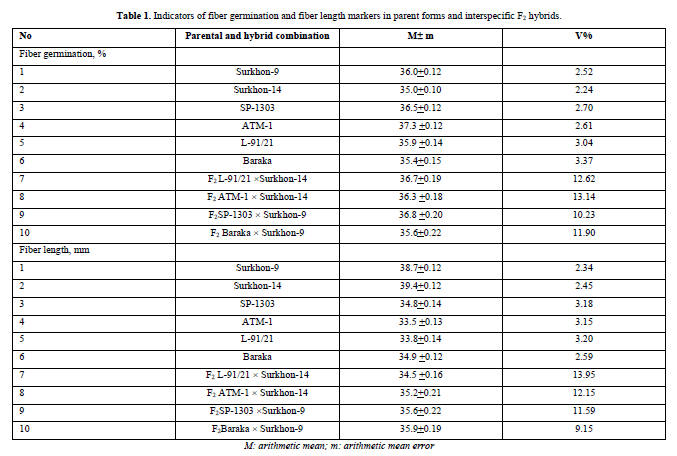
The average indicators of hybrids for this trait were in an intermediate position, a positive shift was observed under the influence of the genotype of the Surkhan variety with a high fiber length. The fiber length of the F2 L-91/21 × Surkhan-14 hybrid combination averaged 34.5 mm, while the fiber length of the remaining 3 hybrid combinations (F2 Baraka × Surkhan-9, F2SP-1303 × Surkhan-9, F2 ATM-1 × Surkhan-14) was 35.2 and 35.9 mm.
The analysis of hybrids of the F3 generation according to the studied signs showed the presence of changes in the positive direction. The indicators of the parent forms in terms of fiber yield and fiber length markers were about the same as in the previous year, without any noticeable changes. This indicates that the parent forms are stable based on. This can also be explained by the low level of their volatility.
The second direction of research used the analyzer line L-70 (DANS) was used, which has absolutely naked seeds, as well as isogenic lines L-489, L-15, which have fluff and fiber, as well as introgressive lines L-620, L-4112 and L-39, which have high-quality and long fiber. According to the plumage of mares, the starting lines are characterized by the following genotypes: L-70 - IIft1ft1ft2ft2fcfc; L-489 - iiFt1Ft1Ft2Ft2FcFc; L-15 - iiFt1Ft1Ft2Ft2fcfc; L-620 - iiFt1Ft1Ft2Ft2FcFc; L-4112 - iiFt1Ft1Ft2Ft2FcFc; L-39 - iiFt1Ft1Ft2Ft2FcFc.
As can be seen from the data in Table 1, among the lines studied, L-489 (PS-type seed fluff) had the highest fiber yield (42.63±0.49%). When crossing this line with the analyzer line L-70 in the hybrid combination of F1 plants L-489 × L-70, the average fiber yield was 32.73±0.17%, respectively, the variation coefficient showed 5.93%, hp reached 0.9, heritability was manifested in the dominance of the L-489 line. Another line L-15 (n-MS - seed fluff type, only micropylar pubescence) showed 41.31±0.26% of the average fiber yield, and when crossing this line with the analyzer line L-70 in the combination of F1 plants L-15×L-70, the average fiber yield was 22.02±0.27%, respectively, the variation coefficient showed 13.9% and hp was 0.1, at which incomplete dominance of this trait was observed. The fact that the main and additional genes providing inheritance of fiber germination in the L-489 line in experiments were in the dominant state, while the inheritance of fiber yield in the dominant state in first-generation hybrids and vice versa, in the recessive state of the additional Fc gene in the L-15 line, led to inheritance of the fiber yield index in the intermediate state of F1 hybrids. It was found that the value and significance of the L-489 line as a source material for practical selection or a donor for this trait is higher than that of the L-15 line (Table 2 & Figure 1).
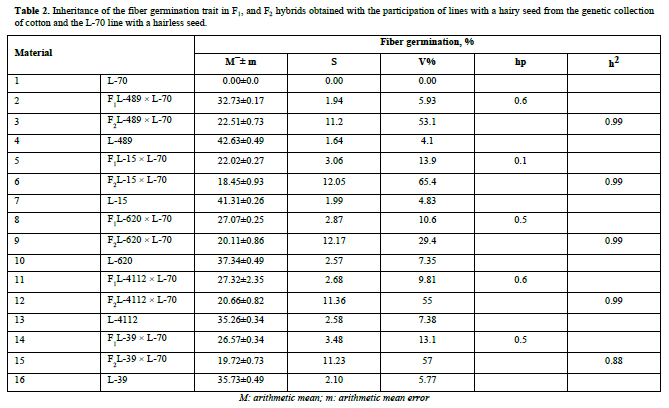
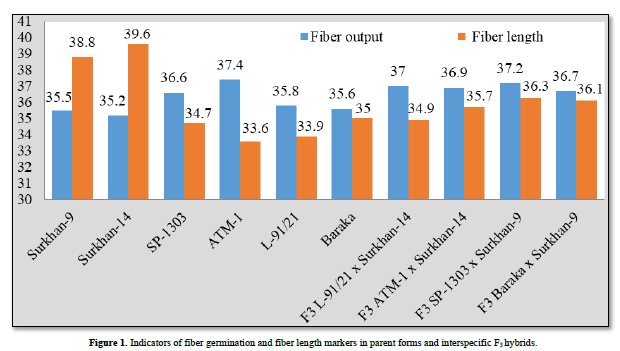
It was obtained from crossing the lines L-620 (37.34±0.49%), L-4112 (35.26±0.34%), and L-39 (35.73±0.49%) with an average fiber yield (PS-type lines, (pubescent seeds) seed fluff) with the line L-70. Average fiber yield values in hybrid combined plants F1L-620 × L-70, F1L-4112 × L-70 and F1 L-39 × L-70(27,07±0,25%, 27,32±2,35% and 26.57±0.34%, respectively) in a state of incomplete dominance (hp=0.5; hp=0.6 and hp=0.5) heredity is observed. Consequently, the yield of F1 fiber in combinations was caused by a decrease in the indicator of this trait when the I-inhibitor gene in the L - 70 line, which prevents plumage on the seed, passed into a heterozygous state in hybrids.
In particular, the average values of fiber length (27.19±0.19, respectively) in hybrid plants F1 L -489 × L-70 and F1 L -15 × L-70 obtained by crossing the L-70 line with short-fiber lines L-489 (27.2±0.50 mm) and L-15 (29.2±0.21 mm) mm and F1 L-15×L-70 mm.), close to the indicators of the lines involved as a mother, and the dominance coefficients (hp =1 and hp=0.9) showed that the trait is inherited in the dominance of these lines in F1 hybrids (Table 3).
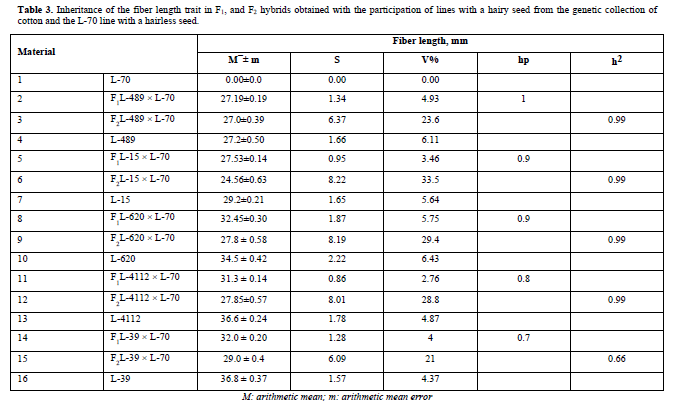
L-4112 with relatively low fiber length L-620 and high L-39 lines F1L-620 × L-70, F1L -4112 ×L-70, and F1L -39 × L-70 hybrid combined installations also have average values (32.45±0.30 mm, 31.3±0.14 mm and more) accordingly. 32.0 ± 0.20 mm), close to the indicators of the lines obtained as maternal, and the dominance coefficients (hp= 0.9; hp =0.8 and hp =0.7) showed that the inheritance of the trait occurred when these lines were dominant. This indicates that the genes controlling the studied trait are inherited independently of the genes providing plumage on the embryo.
It can be seen that the average values of the fiber length label in F2 hybrid combined plants decreased compared to the lines participating as mothers and F1 hybrid plants, but expanded the range of variations. For example, the lowest average value for fiber length was observed in the combination F1 L -15 × L-70 (24.56±0.63 mm), while the limit of the variation range was in classes from 15.0 mm to 33 mm, while a higher average value was noted in the combination F2 L -39 × L-70 (29.0±0.4 mm) when the variation range threshold ranged from 15.0 mm to 37 mm. The variation range of the F2 L - 620 × L-70 hybrid combination included 14 classes (11.0-37.0 mm) with an average fiber length of 27.8±0.58 mm. It was noted that during the transmission of a trait from generation to generation, the influence of the genotype is at a level from moderate to strong (h2=0.66-0.99) (Table 3).
Thus, the genes controlling the inheritance of fiber length in the L-4112, L-39, and L-620 lines are in a dominant state, which is consistent with the opinion expressed in the analysis of fiber germination that their higher concentrations make these lines more valuable and important compared to the L-line 489 as a starting material or fiber length donor for practical selection, allows you to evaluate. The genotype of the L-70 line of the DANS type also contains genes that secretly determine fiber yield and length, while the L- 489, L-620, L-4112, and L-39 lines, which have PS-type pubescent seeds, and the n-MS type lines of the L-15 contain genes which provide fiber output and fiber length. Depending on the concentration of dominant alleles, the hybrids of the first generation showed signs of low, medium, and high fiber.
In the third direction of research, еhe average value of these hybrids in terms of fiber yield was in the range of 36.5-40.0%, depending on the combinations. In the combination of F2 L-1313 × Sulton, the fiber yield was higher, with a large arrangement of plants in the right classes of the variation series, the manifestation of many positive transgressive forms, which also provided an average of 40%. A lower character score was observed in the F2 Fazo × T-1380 combination, and the average score was 36.2%. In all hybrid combinations, unlike the parent forms, manifestations of plants with a fiber yield of 40-45% were observed, which confirms the possibility of creating varieties with a high fiber yield based on the use of a line, and varieties.
This article analyzes the average performance of hybrid combinations according to the main indicators of fiber quality spinning coefficient, micro neuron index, high average fiber length, and specific tensile strength.
Positive and negative results were obtained depending on the combinations of qualitative fiber parameters in the studied hybrids. Among the hybrids, a large number of plant secretions of fibrous type II-IV with positive qualitative indicators were revealed.
The low result in the yarn spinning coefficient F2 related to the combination L-267 × Steam-102 and amounted to 137. In the combinations F2 L -267 × Sultan and F2 L-7979 ×Bukhara-102, these indicators were also relatively low-142 and 148, respectively. The indicators of the remaining hybrids were higher than 152, while the yarn spinning coefficient for 4 combinations of hybrids was in the range of 152-160, and for 4 combinations of hybrids - in the range of 161-168. Among the studied hybrid combinations, the F2 Fazo × T-1380 combination had the best result, the result of which was 171. It was found that the required yarn spinning coefficient corresponds to the majority of the studied hybrid combinations (Table 4).
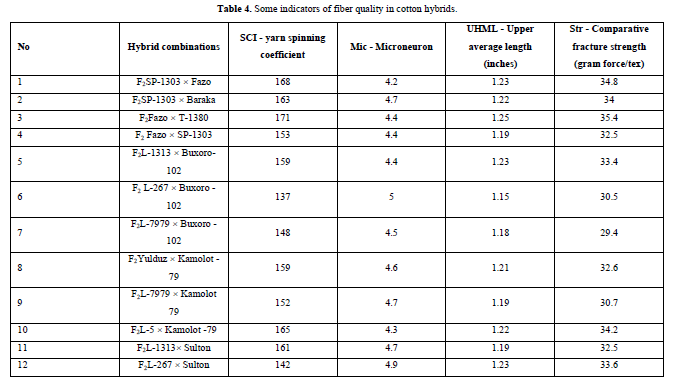
According to the micro neuron index, the F2 SP-1303 × Fazo combination showed the best result with an average of 4.2, and the negative result belonged to the F2 T-267 × Bukhara -102 combination with a micro neuron index of 5.0. It was found that 10 of the 12 studied hybrid combinations had micro neuron indices in the range of 4.2-4.7, while 6 of them had micro neuron counts below 4.5. This indicates that their fiber is fully compliant with Type II-III requirements, while the fiber is fully mature and at the level of fineness requirements.
The best result in the upper average fiber length was observed in the F1 Space × T-1380 combination, which was 1.25 inches (code 40) and met the criteria of industrial type II. A positive result was also observed in the combinations F2 SP-1303 × Fazo, F2 L-1313 x Bukhara-102, and F2 L -267 × Sultan, while the average value of these combinations was 1.23 inches. It should be particularly noted that in 7 of the 12 hybrids studied, the marking index exceeds 1.20 inches. Considering that, according to the criteria of 1.18-1.23 inches, they meet the industrial requirements of type III according to the HVI system, the high average fiber length of the 10 studied hybrid combinations fully meets the requirements of type III. Among the hybrids, a relatively low result was observed only in one combination F2 L-267 × Bukhara -102 with an index of 1.15 inches, which meets the industrial requirements for type IV fiber. Thus, it was found that the average indicator of hybrids on this basis fully meets the requirements of type II-IV.
The comparative fracture strength is also one of the indicators that determine the quality of the fiber. The combination F2 L-7979 × Bukhara-102 found a relatively low result on this designation, with an average of 29.4 gf/tex. In the remaining hybrid combinations, the average specific length of the fiber was in the range of 30.5-35.4 g force /tex, and the best result was recorded in the combination of F2 Fazo ×T-1380.
DISCUSSION
It was revealed that the fiber length of these (F2 Baraka x Surkhan-9, F2SP-1303 × Surkhan-9, F2 ATM-1 × Surkhan-14) hybrid combinations shifts to the positive side under the influence of varieties belonging to the G. barbadense L. species, participating in the paternal form. A greater location of plants of the variation series in the middle and right classes is noted. The coefficient of variation for this feature, as well as for the fiber yield feature, was higher in hybrid combinations. Comparatively high efficiency was revealed in the combination F2 L-91/21 × Surkhan-14. This confirms that new recombinants are able to distinguish forms even by fiber length due to combination variability.
The F3 hybrids showed a significant positive change in the trait compared to F2. The F3 Baraka × Surkhon-9 combination with an index of 36.7% had a relatively low result in terms of fiber yield, and the F3 SP-1303 × Surkhon-9 combination had a high result (37.2%). The F3 ATM-1 × Surkhon -14 and F3 L-91/21 × Surkhon-14 combinations also had relatively high fiber yield, averaging 36.9% and 37.0%, respectively. Although the coefficient of variability decreased compared to F2, it was significantly higher compared to the parent forms. This suggests that the separation process is still underway in hybrid combinations.
The same pattern was observed based on fiber length, while an increase in indicators was observed in hybrid combinations. The best average fiber length was observed in the combination F3 SP-1303 x Surkhon-9, the average of which was 36.3 mm. Although the literature indicates the existence of an inverse correlation between fiber yield and fiber length, higher values for both signs were found in this combination. This confirms that the inverse correlation between these traits can be changed positively based on the hybridization of forms belonging to different genotypes. A relatively low result in fiber length was observed in the combination F3 L-91/21 × Surkhon-14, with an average of 34.9 mm. However, in the F3 ATM-1 x Surkhon-14 and F3 Baraka x Surkhon-9 combinations, the average was 35.7 mm and 36.1 mm, respectively. It was found that recombinants with a fiber length of 38-41 mm are distinguished among hybrid plants. It was also noted that the forms characteristic of varieties of the species G. hirsutum L. in terms of yield, precocity, and some other characteristics, but characteristic of varieties G. hirsutum L. in terms of fiber length.
The averaging of fiber yield markers in F2 hybrid plants, combined with a decrease due to the separation observed in this generation, led to an increase in the number of classes of the variation series and, accordingly, the coefficient of variation. For example, the fiber yield of hybrid combined plants F2 L -489 × L-70 and F1 L-15 × L-70 averages 22.51±0.73% and 18.45±0.93%, respectively, while the limit of the variation series starts from 0.0% in both combinations and is 45.0% in the combination F2 L -489 × L-70., While the combination F2 L-15 × L-70 is completed at the threshold of 39.0%. In addition, the variation series of hybrid combined plants F2 L-620 × L-70 and F2 L-4112 × L-70 ranged from 0.0% to 41.0% with average values of 20.11±0.86% and 19.72±0.73%, respectively. However, on combined installations, F2 L -39 × L-70, the limit of the fiber yield range was from 0.0% to 39.0%, including 20 classes. The average value of the trait was 19.72±0.73% and the heritability coefficient was. In all F2 hybrid combinations studied, it was found that the influence of the genotype on the transmission of a trait from generation to generation was strong (h2=0.88-0.99).
While the L-70 line has no fiber according to the investigated feature, the rest of the original lines differ sharply in the average value of this feature.
The HVI system criterion specifies a specific break strength of 30.0-35.0 gf/tex for the I-III cotton fiber type. It can be seen from this that the specific discontinuity strength indicators of the fiber of all hybrid combinations studied meet the requirements of Type I-III. The results obtained allow the creation of varieties whose fiber is suitable for Type I-III requirements, based on the hybridization of varieties and lines that differ genotypically from each other.
CONCLUSION
In cotton, it has been confirmed that by interspecific hybridization, hybrid combinations can be created that surpass the parent forms in fiber yield and fiber length. It was found that the marking of fiber length in the studied hybrid combinations shifts in a positive direction under the influence of the genotype of G. barbadense L. varieties.
Hybridization of varieties G. hirsutum L. and G. barbadense L. has established that in the F2-F3 generations recombinants with a fiber yield of 38-45%, fiber length of 38-41 mm can be isolated, and the hybrid combination F3 SP-1303 × Surkhon-9 gives high efficiency according to the studied characteristics.
In the mutant lines L-4112, L-39, and L-620, it was estimated that the genes involved in the inheritance of fiber length are in a dominant state, while the value of the lines L-4112, L-39, and L-620 as fiber length donors were relatively high;
The genotype of the L- 70 line of the DANS type contains genes that latently determine fiber length and fiber length, while the L-489, L-620, L-4112, and L-39 lines with OS-type germ plumage and L-15 lines of the N-MS type contain dominant alleles of the main genes providing fiber output and fiber length. It has been established that in hybrids of the first generation, depending on the concentration, manifestations are low, medium and high.
It was noted that in hybrids with the participation of genotypically sharply differentiated varieties and lines belonging to the G. hirsutum L. species, fiber quality indicators differed depending on the combinations, while fiber quality in most plants was positive, and in plants with a relatively negative indicator, manifestations were also observed. It is confirmed that among the hybrids many forms make it possible to create varieties that meet the requirements of the industrial type of cotton I-III.
No Files Found
Share Your Publication :